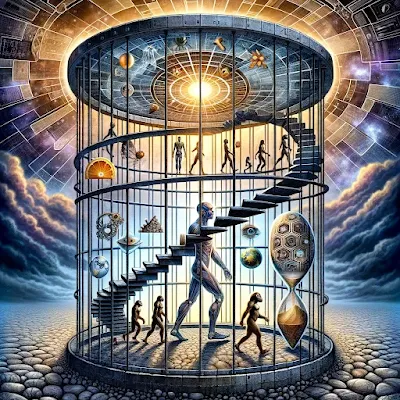Cooperation – this is how life works!
05 January 2024
The Dichotomy of Morality: From Nature’s Neutrality to Human Constructs
04 January 2024
Exploring the 'Human Biological Evolutionary Cage': Ancestral Diet and Modern Health
Human Biological Evolutionary Cage
Our health and well-being are intricately tied to our evolutionary past, a concept embodied by what I refer to as the Human Biological Evolutionary Cage, or HBEC for short. This framework underscores the fact that despite our technological prowess, symbolized by the cars we drive and the rockets we launch into space, our biological evolution lags behind our cultural and technological advances. The HBEC represents the physiological boundaries within which we must navigate our dietary and lifestyle choices to align with our genetic heritage.
The Quest for Optimal Diet and the Role of Our Evolutionary Blueprint
In our quest to understand the optimal diet for modern health, we often overlook the evolutionary blueprint that has shaped our dietary needs. This journey takes us back to the 'Human Biological Evolutionary Cage' – a concept that profoundly impacts our understanding of human evolution and dietary development. Here, we explore how our ancestral diets, heavily reliant on meat and minimal in processed foods, contrast sharply with today's eating habits, and what this means for our health.
Unlocking the 'Human Biological Evolutionary Cage''
The 'Human Evolutionary Cage' refers to the evolutionary constraints that have historically dictated human dietary patterns. Our skeletal traits, such as endurance running capabilities, thermoregulation, and the use of tools for meat consumption, point towards a diet that was significantly meat-based. These adaptations highlight our species' long-standing reliance on animal-based nutrition.
Meat-Centric Diets of Our Forebears: Evolutionary Insights
Our ancestors' diet was primarily centered around meat, a nutrient-dense and energy-rich source of food. Plant-based foods played a role, but their availability was heavily influenced by seasonal changes. Archaeological findings, like the Schöningen Spears, provide evidence of early human hunting practices and meat consumption, underscoring the importance of animal-based foods in our evolutionary history.
From Ancestral Roots to Modern Plates: The Dietary Divergence
Dr. Ken Berry's 'Principles of a Proper Human Diet' suggest a return to this ancestral way of eating. Modern diets, with their heavy reliance on processed foods and carbohydrates, starkly contrast with what our bodies have evolved to consume. This recent dietary shift is at odds with our biological adaptations, which have not significantly changed in a mere 15,000 years – a blink in evolutionary terms.
Proper Human Diet: A Beginner’s Guide
Health Through the Ages: Ancestral Diets Meet Modern Biology
Aligning our modern diet with ancestral eating patterns could have significant health benefits. The mismatch between our evolutionary adaptations and current dietary habits contributes to numerous health issues. Ancestral diets, lower in processed foods and carbohydrates, could provide a template for healthier eating in the modern world.
Through the Lens of TPOCo: Dietary Choices and Evolutionary Wisdom
Applying The Principle of Collaboration and Cooperation (TPOCo) principles, we can better understand the evolution of human diets. Modern dietary lifestyles like Keto, Ketovore, Carnivore, and the Lion's diet, which emphasize minimal processed food intake, resonate with our ancestral dietary patterns. It’s crucial to recognize the influence of philosophy, religion, and sometimes biased science in shaping our dietary choices.
Echoing Our Ancestors: The Vitality of Movement for Modern Health
Ancestral Movement in a Modern World
In the narrative of ancestral health, diet often takes centre stage, but the saga is incomplete without the integral role of physical activity. Our ancestors led lives rich in movement, a stark contrast to today's sedentary norms. Understanding this contrast is key to grasping the full scope of our inherited health blueprint.
Reawakening Our Hunter-Gatherer Physique
The hunter-gatherer lifestyle was defined by constant motion: walking vast distances, endurance hunting. sprinting from predators or towards prey, and the lifting and carrying of daily necessities. These activities sculpted a physique that modern gyms strive to replicate. Today, rekindling these ancestral movements can awaken dormant physical potential, leading to robust health and vitality.
Modern Sedentary Lifestyle vs. Ancestral Activity
Our modern world often traps us in a cycle of inactivity, chaining us to desks and devices, a far cry from our forebears' dynamic way of life. The cost is not just muscular atrophy but a cascade of health maladies. Acknowledging this disparity is the first step toward cultivating an environment that encourages movement.
Integrating Ancestral Movement into Daily Life
Bridging the millennia-wide gap requires conscious effort.
We can integrate ancestral movement by choosing stairs over elevators, walking or cycling over driving, and engaging in regular strength training that echoes the physical tasks of our ancestors. These practices aren't mere exercises; they're a reconnection with our evolutionary heritage.
The Holistic Approach: Merging Diet and Movement
To fully honour our evolutionary past, we must pair the wisdom of ancestral diets with the ethos of physical activity. This holistic approach to health—balancing nutrient-dense foods with consistent, varied movement—isn't just about longevity; it's about quality of life. It's a testament to the resilience of the human species and a path to reclaiming the robust wellness that is our birthright.
Embracing HBEC: Aligning Ancestral Wisdom with Today’s Lifestyle Choices
Our journey through the 'Human Biological Evolutionary Constraints' (HBEC) has illuminated not just our dietary roots but also the vital role of physical activity inherent to our species. These twin pillars of ancestral health—nutrition and movement—offer invaluable insights into optimizing our well-being. As we traverse the complexities of modern nutrition and sedentary lifestyles, it's paramount to make informed choices that honour both our evolutionary heritage and the demands of contemporary life. By aligning our eating habits with those of our forebears and mimicking their physical vigour, we step closer to a holistic approach to health—one that respects the ancient wisdom encoded in our very genes while embracing the conveniences of modernity.
Let us not only eat but also move as our ancestors did, for it is in this harmonious blend of past and present that our truest health potential lies.
This striking image invites us to ponder our place within the vast tapestry of evolution. It prompts us to ask: how can we live in harmony with our biological heritage in this age of rapid technological and social change? Share your thoughts on how this visual representation of the HBEC resonates with your understanding of our ancestral legacy and modern health.


